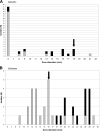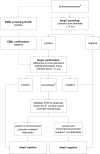Practical approach for reliable detection of AmpC beta-lactamase-producing Enterobacteriaceae
- PMID: 21632895
- PMCID: PMC3147735
- DOI: 10.1128/JCM.00404-11
Practical approach for reliable detection of AmpC beta-lactamase-producing Enterobacteriaceae
Abstract
In this prospective study all Enterobacteriaceae isolates (n = 2,129) recovered in the clinical microbiology laboratory during October 2009 to April 2010 were analyzed for AmpC production. Clinical and Laboratory Standards Institute (CLSI) cefoxitin and cefotetan susceptibility breakpoints and CLSI critical ESBL diameters were used to screen for potential AmpC producers. In total, 305 isolates (211 potential AmpC producers and 94 AmpC screen-negative isolates as a control group) were further analyzed by multiplex PCR for the detection of plasmid-encoded ampC beta-lactamase genes and by ampC promoter sequence analysis (considered as the gold standard). Cefoxitin and cefotetan were assessed as primary screening markers. The sensitivities of cefoxitin and cefotetan for the detection of AmpC production were 97.4 and 52.6%, respectively, and the specificities were 78.7 and 99.3%, respectively. As a phenotypic confirmation test, the Etest AmpC and the cefoxitin-cloxacillin double-disk synergy method (CC-DDS) were compared. The sensitivities for the Etest AmpC and the CC-DDS method were 77.4 and 97.2%, respectively, and the specificity was 100% for both methods. The results of the Etest AmpC were inconclusive for 10 isolates. With the CC-DDS method 2 inconclusive results were observed. Based on this study, we propose a comprehensive diagnostic flow chart for the detection of AmpC production consisting of a simple phenotypic screening and a single phenotypic confirmation test with inconclusive results being resolved by molecular analysis. For the proposed flow chart using (i) cefoxitin as a screening marker for AmpC production, (ii) the CC-DDS method as phenotypic confirmation, and (iii) molecular methods in case of inconclusive results, the sensitivity and specificity for AmpC detection would have been 97.4 and 100%, respectively, with respect to the studied isolates. The phenotypic methods used in the AmpC algorithm are simple to perform and easy to implement in the diagnostic laboratory.
Figures

 ) and chromosomal ampC promoter mutations (▪, E. coli only) are given; the CLSI 2009 susceptibility breakpoints are indicated by black arrows.
) and chromosomal ampC promoter mutations (▪, E. coli only) are given; the CLSI 2009 susceptibility breakpoints are indicated by black arrows.

References
-
- Caroff N., Espaze E., Berard I., Richet H., Reynaud A. 1999. Mutations in the ampC promoter of Escherichia coli isolates resistant to oxyiminocephalosporins without extended spectrum beta-lactamase production. FEMS Microbiol. Lett. 173:459–465 - PubMed
-
- Caroff N., Espaze E., Gautreau D., Richet H., Reynaud A. 2000. Analysis of the effects of −42 and −32 ampC promoter mutations in clinical isolates of Escherichia coli-hyperproducing ampC. J. Antimicrob. Chemother. 45:783–788 - PubMed
-
- Clinical Laboratory Standards Institute 2009. Performance standards for antimicrobial susceptibility testing; 19th informational supplement. Document M100-S19, ISBN 1-56238-690-5. Clinical Laboratory Standards Institute, Wayne, PA
Publication types
MeSH terms
Substances
LinkOut - more resources
Full Text Sources
Medical
Research Materials
Miscellaneous

